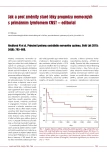Aortic pulse wave velocity in patients with metabolic syndrome and hypertension treated with sartans
Authors:
J. Špác; M. Souček; I. Řiháček; H. Němcová
; L. Pluháček
Authors‘ workplace:
II. interní klinika Lékařské fakulty MU a FN u sv. Anny Brno, přednosta prof. MUDr. Miroslav Souček, CSc.
Published in:
Vnitř Lék 2010; 56(8): 880-883
Category:
50th Birthday - Jindřich Špinar, MD, CSc., FESC
Overview
Introduction:
The incidence of subclinical organ damage is higher in patients with hypertension (HT) and metabolic syndrome (MS). Increased aortic pulse wave velocity (PWV) is one the markers reflecting subclinical arterial damage. Treatment with sartans leads not only to a reduction of blood pressure but may also bring regression of the subclinical damage. Long-acting sartans (telmisartan) may be more effective than sartans with medium duration of action (losartan); the aim of this research was to compare the impact of hypertension therapy with losartan and telmisartan on aortic pulse wave velocity (Ao-PWV).
Methods:
We examined 32 patients with HT and MS, 15 patients were treated with losartan 50 mg (group A) and 17 patients were treated with telmisartan 80 mg (group B). At the beginning and the end of the study, PWV was measured using the Complior method and 24-hour BP monitoring and biochemistry testing were carried out.
Results:
Treatment with sartans led to a reduction in BP in both groups, daytime BPs/BPd declined by 11.5/9.0 mm Hg in group A and by 13.8/8.1 mm Hg in group B, respectively, and night time BP declined by 5.7/5.1 mm Hg in group A compared to 7.4/3.89 mm Hg in group B. Aortal pulse wave velocity declined by 1.94 m/s in group A (p < 0.001) and by 0.46 m/s in group B (p < 0.001), respectively.
Conclusion:
Treatment with losartan as well as telmisartan resulted in reduced values of BP and Ao-PWV. We did not prove a more significant effect of a long-acting sartan (telmisartan) compared to a sartan with a medium duration of action (losartan) on Ao-PWV reduction after 1 year of treatment.
Key words:
aortic pulse wave – metabolic syndrome – hypertension – sartans
Sources
1. Laurent S, Cockcroft J, Van Bortel L et al. Expert consensus document on arterial stiffness: methodological issues and clinical applications. Eur Heart J 2006; 27 : 2588–2605.
2. Asmar R, Gosse P, Topouchian J et al. Effects of telmisartan on arterial stiffness in Type 2 diabetes patients with essential hypertension. J Renin Angiotensin Aldosterone Syst 2002; 3 : 176–180.
3. Widimsky J Jr, Petrák O, Štrauch B et al. Ovlivnění periferního a centrálního krevního tlaku losartanem. Cor Vasa 2010; 52 : 183–186.
4. Karalliedde J, Smith A, DeAngelis L et al. Valsartan improves arterial stiffness in type 2 diabetes independently of blood pressure lowering. Hypertension 2008; 51 : 1617–1623.
5. Reid JL. Molecular–specific effects of angiotensin II antagonists: clinical relevance to treating hypertension? J Renin Angiotensin Aldosterone Syst 2005; 6 : 15–24.
6. Tropeano AI, Boutouyrie P, Pannier B et al. Brachial pressure‑independent reduction in carotid stiffness after long‑term angiotensin‑converting enzyme inhibition in diabetic hypertensives. Hypertension 2006; 48 : 80–86.
Labels
Diabetology Endocrinology Internal medicineArticle was published in
Internal Medicine

2010 Issue 8
Most read in this issue
- Care for patients on mechanical ventilation from the perspective of an internal medicine physician
- Therapy with implantable cardioverter‑defibrillators (ICD) in the early of third millenium
- Anaemia in chronic heart failure
- Changes in NT‑proBNP levels in patients with atrial fibrillation related to heart failure
